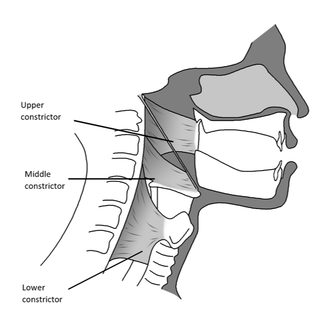Normal muscle tension versus excessive tension

Muscle tension is essential to singing. After all, singing is a physical endeavor. But excessive tension is the enemy of good tonal quality.
Tension often compensates for something that is missing in vocal technique. It can also be a way that our bodies attempt to support or energize sound. The most problematic tensions involve the:
- Neck/larynx/pharynx
- Jaw
- Tongue
- Lips
- Shoulders
- Legs
Pharynx Constriction and Contemporary Styles
The above illustration shows the three constrictor muscles of the pharynx (upper, middle, and lower). When these are tense, the diameter of the pharynx decreases. The middle constrictor is attached to the hyoid bone; since the larynx is suspended from the hyoid bone, constriction of this muscle will affect the larynx as well as the pharynx. The lower constrictor is attached directly to the larynx.
Classical style singers typically know that pharynx constriction causes problems with their sound, but some contemporary singers use constriction deliberately to cause the pharynx to resonate at a higher frequency. This is one way to brighten sound, but it tends to be an overly harsh method. A better approach is modest relaxation of the soft palate, elevating/fronting the tongue, plus shortening the vocal tract by allowing the larynx to rise naturally and widening the lips.Vocal Technique includes an exercise to help combat pharynx constriction.
Classical style singers typically know that pharynx constriction causes problems with their sound, but some contemporary singers use constriction deliberately to cause the pharynx to resonate at a higher frequency. This is one way to brighten sound, but it tends to be an overly harsh method. A better approach is modest relaxation of the soft palate, elevating/fronting the tongue, plus shortening the vocal tract by allowing the larynx to rise naturally and widening the lips.Vocal Technique includes an exercise to help combat pharynx constriction.
Tips for Reducing Tension
Use Good Breath Support
Singers who have good breath support (see the Breathing Tips page) will be less likely to constrict neck muscles and those surrounding the larynx and pharynx. When these muscles are too tense, singers often sound harsh or strident and the quality of vibrato suffers.
Jaw Tension
Singers often open their mouths and jaws too much in an effort to create resonance. This will create jaw tension. For example, they may have been told to "open the mouth" or "drop the jaw."
Here are a couple of exercises to combat jaw tension:
Try sustaining "ah" while gently massaging the jaw joints with a finger.
Wiggle the jaw from side to side while vocalizing. Singers can look at themselves in a mirror at home and move the jaw slowly up and down within a limited range. Remember to release the jaw in the back when opening it to get a sense of what it feels like to move the jaw without tension. Then increase the range of movement.
External Signs of Tension
Voice teachers and choral conductors should watch for external signs of tension. These may include:
Some of the additional topics covered in Vocal Technique
Singers who have good breath support (see the Breathing Tips page) will be less likely to constrict neck muscles and those surrounding the larynx and pharynx. When these muscles are too tense, singers often sound harsh or strident and the quality of vibrato suffers.
Jaw Tension
Singers often open their mouths and jaws too much in an effort to create resonance. This will create jaw tension. For example, they may have been told to "open the mouth" or "drop the jaw."
- Opening the mouth is not bad per se (and is particularly useful for contemporary styles), but problems occur when we open our mouths too far. For instance, some conductors tell their singers to insert three fingers in their mouth. That can be excessive for singers of any style.
- The jaw does need to be opened in the back to improve resonance for classical styles, but singers may respond to advice to "drop the jaw" by opening the front excessively and/or holding the jaw open in a fixed position. Tension can accumulate, and the position of the jaw may become rigid and tight.
Here are a couple of exercises to combat jaw tension:
Try sustaining "ah" while gently massaging the jaw joints with a finger.
Wiggle the jaw from side to side while vocalizing. Singers can look at themselves in a mirror at home and move the jaw slowly up and down within a limited range. Remember to release the jaw in the back when opening it to get a sense of what it feels like to move the jaw without tension. Then increase the range of movement.
External Signs of Tension
Voice teachers and choral conductors should watch for external signs of tension. These may include:
- Jutting the chin forward
- Raising the chin--this is appropriate in contemporary styles for higher pitches to allow some rising of the larynx, but the chin should not always be raised
- Lifted shoulders
- Extraneous movement of the arms, head and body, swaying (un-choreographed movement)
- Forced smile
- Raised eyebrows
Some of the additional topics covered in Vocal Technique
- Managing tongue tension
- Indicators of lip tension
- Relaxing the shoulders
- Temporomandibular joint (TMJ) disorder and jaw tension
- Illustrations of anatomy related to tension
- Photographs to help recognize tension
- Posture and knee locking
- Exercises for reducing tension